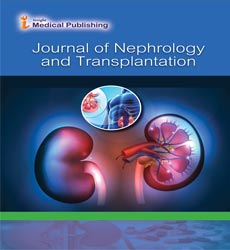Polycystic Kidney Disease: Causes, Complications and T reatment
Michel Phair*
Department of Internal Medicine, University of Knockrooskey, Westport, County Mayo, Ireland
- *Corresponding Author:
- Michel Phair
Department of Internal Medicine,
University of Knockrooskey,
Westport,
County Mayo,
Ireland
E-mail: MichelPhair@calsu.us
Received Date: December 08, 2021; Accepted Date: December 20, 2021; Published Date: December 27, 2021
Citation: Phair M (2021) Polycystic Kidney Disease Causes, Complications and Treatment. J Nephrol Transplant Vol.5 No.5: 003.
Description
Polycystic kidney disease (PKD) is a hereditary disease. Those who have it develop fluid-filled cysts in their kidneys. These cysts can change the shape and size of important organs. Therefore, the disease is a serious condition that can cause life-threatening complications. People with PKD develop multiple cysts in their kidneys. These cysts are filled with fluid. Over time, they can enlarge and change the shape of their kidneys. The kidney is a fist-sized bean-shaped organ. Humans usually have one on each side of the body below the thorax and it is attached to the inside of the abdominal wall. Their job is to filter the blood to remove waste products and excess water from the body. Make sure the blood contains a healthy balance of water, salt, and minerals to ensure that our nerves, muscles, and other body tissues function normally. The kidneys also produce the hormones that the body needs to control blood pressure and produce red blood cells. PKD interrupts this important work. As cysts grow, they can expand, reshape, and even lead to kidney failure. Cysts can also occur in other important organs, such as the liver.
What we Know About Polycystic Kidney Disease?
Causes and risk factors of polycystic kidney disease
Gene mutations cause PKD. In most cases, this means that the disease is inherited from parent to child in DNA. From time to time, one can develop a genetic mutation that causes PKD without inheriting it from their parent. Scientists call this is a "spontaneous gene mutation," and it is rare. PKD affects men and women equally. Age, race, and ethnicity do not appear to affect the likelihood of a person developing a disability. However, people who are related to PKD are more likely to be in that state than those who are not.
Symptoms of polycystic kidney disease
People can live with Autosomal Dominant Polycystic Kidney Disease (ADPKD) for years without knowing it. They are usually not diagnosed until the age of 30–50, when complications occur. Symptoms of ADPKD include side and back pain, headache, and hematuria. Autosomal Recessive Polycystic Kidney Disease (ARPKD) is much rarer than ADPKD, but doctors can detect it before the baby is born. Signs include a large-looking kidney in the foetus and a lack of amniotic fluid in the uterus, both of which can be detected by ultrasound. Signs of ARPKD after birth include high blood pressure and dyspnea. Swelling of the abdomen, vomiting after eating, problems with growth of the face and limbs. According to the American Kidney Fund (AKF), children with ARPKD may be asymptomatic unless they have a serious illness. These children may experience the following symptoms which are high blood pressure, urinary tract infections, back or side pain and varicose veins too.
Complications of polycystic kidney disease
Kidney failure: When the kidneys become enlarged and it will reshaped, they do not function properly. As a result, harmful waste products accumulate in the body and increase blood pressure. People with renal failure can retain excess water, and their bodies may not be able to make enough red blood cells.
Liver cysts : According to the PKD Foundation, more than 80% of people with PKD develop cysts in their liver. Among those with PKD, cysts are more common in females than in males. The cysts tend to be very small, meaning that it is rare for them to contribute to liver failure. They can, however, become infected. The symptoms of an infected liver cyst include fever and pain in the upper right hand side of the abdomen.
Mitral valve prolapse: If person have mitral valve prolapse, it means that the valve that separates the upper and lower parts of the left ventricle of the heart is not functioning properly. Symptoms include palpitation and chest pain.
Hernias: Hernias in the abdomen and groin are more common in people with PKD than in those without the condition.
Treatment for polycystic kidney disease
There is currently no cure for adult PKD, but doctors will work with people to manage the complications and help to slow the rate at which the cysts grow. A healthful lifestyle that includes regular exercise and a balanced diet can help delay or prevent kidney failure. Reducing stress and quitting smoking also contribute to overall good health. In some cases, doctors may recommend that people take medication to control their blood pressure. Depending on the severity of the condition, treatment for ARPKD, or PKD in infants and children, may include: growth hormones, medication to lower blood pressure, antibiotics, dialysis, a kidney transplant and a liver transplant.
Open Access Journals
- Aquaculture & Veterinary Science
- Chemistry & Chemical Sciences
- Clinical Sciences
- Engineering
- General Science
- Genetics & Molecular Biology
- Health Care & Nursing
- Immunology & Microbiology
- Materials Science
- Mathematics & Physics
- Medical Sciences
- Neurology & Psychiatry
- Oncology & Cancer Science
- Pharmaceutical Sciences
